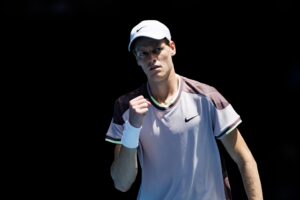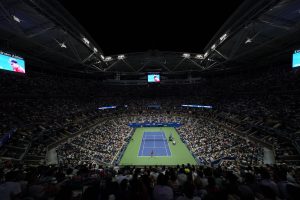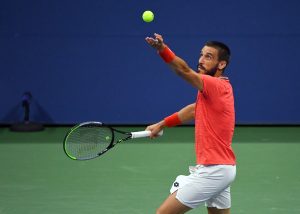Before the grass-court-concluding event in Newport, Jenson Brooksby had never played a professional grass-court tournament before. In fact, he hadn’t played even junior Wimbledon before.
It was a completely new experience for the 20-year-old American, whose toe injury forced him off of the tour for 14 months before coming back earlier this season.
Jenson Brooksby in 2021
Brooksby had already proven himself on hard courts and clay this season. Brooksby is 8-1 on clay and 20-4 on hard for the season. He won two hard-court Challengers and made the final of another on indoor hard.
And, on clay, he won the green clay Challenger tournament in Tallahassee. He also qualified for the French Open, including two come-from-behind victories over Marc-Andrea Huesler and Evan Furness in the final two qualifying rounds. Against Furness, he saved three match points in an epic comeback.
Brooksby’s game translates well to clay and hard. He’s extremely consistent from the baseline, gets good depth on his shots, and ramps up the aggression, especially from backhand side, when the opportunity presents itself. Brooksby anticipates well and has an elite ability to turn defense-into-offense at the blink of an eye. And with varied shot selection and angles, his opponents often struggle to figure out where to position themselves on the court.
But, given that his serve is his biggest weakness, he hasn’t looked overly comfortable at the net, and he doesn’t often overwhelm opponents with pace from the baseline, how Brooksby would make the transition to grass was certainly not a given.
But, perhaps there shouldn’t have been any doubt that Brooksby would adapt to anything the tour throws at him.
Brooksby’s first time on red clay was at Roland Garros this year. As he told the ATP regarding his mindset to switching to such an unfamiliar surface, “I think it’s just a testament to our mindset that we have. We don’t worry about surface and things like that. I just focus on what’s in my control, which is how I’m playing [and] the intentions I have going out on the court.”
This was a fascinating look into Brooksby’s mindset. The American felt that if he played his game, the surface wouldn’t matter.
Moving to Grass
But, that wouldn’t mean that adapting to Newport would be easy. Yes, Brooksby had been playing great tennis, having risen in the rankings from World No. 307 at the beginning of the year to World No. 152 before Newport, but the Rhode Island grass was a different beast than what Brooksby was used to.
Newport is known for its serve-centric play, weird bounces, and lack of rhythm that the court gives its players. This was not the pristine courts of Wimbledon, which could have eased the transition for Brooksby. So, how would the American fare?
Pretty good for a first grass-court tournament.
Brooksby won four matches in a row to reach the final of Newport, taking out Evgeny Donskoy, red-hot Denis Kudla, Peter Gojowczyk, and Jordan Thompson in succession. The wins over Kudla and Thompson were particularly impressive, as Kudla went 12-4 this grass-court season and Thompson went 9-5 on the grass this year and beat Kei Nishikori in the second round of Wimbledon.
Brooksby won over 75% of his first-serve points in every match besides against Kudla, where he still won 70% of his first serves while serving at 68% first serves in.
And while Brooksby lost in the final to former Wimbledon (and US Open) finalist Kevin Anderson 7-6(8) 6-4, it was still an excellent performance that saw Brooksby have two set points in the first set.
So, what made Brooksby so successful on the grass? Brooksby adjusted to the random bounces very well and glided around the surface with ease. He really did a good job both disguising and perfectly hitting the drop shot, which was a very effective shot on the low-bouncing courts of Newport. Brooksby also picked the perfect moments to flatten out his groundstrokes and wreak havoc on his opposition.
And it was quite interesting watching Brooksby manage to act as a brick wall out there on the court, even though he was on such a quick surface. Watching him grind down consistent players such as Kudla and Thompson, while stunting the power of someone like Gojowyczk, was incredible to watch.
In fact, Gojowyczk only won 41% of his service points against Brooksby. The German had won at least 66% of his service points in both of his other matches in Newport last week!
Speaking about his preparation for Newport, Brooksby’s answer to Owen Lewis of the Racket Blogwas quite similar, stating, “…I don’t….really worry too much about conditions…I fine-tune little parts of my game…I just try to keep it similar whether it’s on hard, grass, or clay and then adjust to, you know, how the surface plays with bounces, my movement, and things like that.”
And it’s this level-headed demeanor, that ability to not worry overly worry himself about the surface or any external factors that can affect his tennis has made Jenson Brooksby into one of the mentally tough, clutch players on the tour.
Whereas other players can lose focus, get down on themselves, and become negative on the court, Brooksby exudes a consistently positive demeanor, his focus rarely (if ever) wavering and a fierce determination to get that one last ball in play.
While Brooksby will surely go back to his hard-court comfort zone in the lead-up to the US Open, it was a successful first foray onto the grass for the American.
Don’t be surprised to see Jenson Brooksby having success on the fresh-cut grass of Wimbledon next summer.
Main Photo from Getty.






